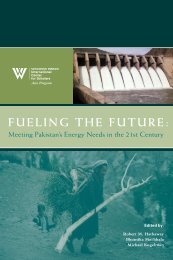Environmental Change and Security Project Report - Woodrow ...
Environmental Change and Security Project Report - Woodrow ...
Environmental Change and Security Project Report - Woodrow ...
Create successful ePaper yourself
Turn your PDF publications into a flip-book with our unique Google optimized e-Paper software.
already contributing to the displacement of<br />
large numbers of people, though reliable<br />
numerical estimates do not exist. In addition,<br />
huge numbers of people are being uprooted by<br />
large-scale infrastructure projects. During the<br />
1990s alone, tens of millions of people worldwide<br />
lost their homes to make way for dams,<br />
roads, logging operations, <strong>and</strong> other projects.<br />
The World Commission on Dams estimates<br />
that 40 million to 80 million people have been<br />
displaced by dams.<br />
What Can Be Done?<br />
Countries, communities, private enterprises,<br />
<strong>and</strong> civil society actors can employ many strategies<br />
to address the complex linkages between<br />
environment, population, development, <strong>and</strong><br />
security. A multifaceted strategy is needed,<br />
including the following elements:<br />
Promote renewable energy <strong>and</strong> energy<br />
efficiency. More aggressively promoting<br />
renewable energy <strong>and</strong> energy efficiency could<br />
substantially reduce reliance on oil <strong>and</strong> other<br />
exhaustible energy resources that contribute to<br />
global climate change <strong>and</strong> fan geopolitical tensions<br />
<strong>and</strong> civil wars. Renewable energy technologies<br />
are developing rapidly, with global<br />
wind power capacity tripling since 1998 <strong>and</strong><br />
climbing more than tenfold over the last<br />
decade. And people living in developing countries<br />
could save up to 75 percent of their energy<br />
by incorporating more energy efficient<br />
cooking <strong>and</strong> heating technologies.<br />
Combat l<strong>and</strong> degradation <strong>and</strong> improve<br />
water productivity through sustainable agricultural<br />
practices <strong>and</strong> other techniques. A<br />
range of sustainable agriculture practices can be<br />
employed to combat l<strong>and</strong> degradation, including<br />
improving fertilization practices, planting<br />
tree crops, <strong>and</strong> shifting to “no-till” farming<br />
practices. With agriculture using about 70 percent<br />
of all the water taken from rivers, lakes,<br />
<strong>and</strong> underground aquifers, less water-intensive<br />
farming methods could greatly improve water<br />
productivity. In general, water scarcity can be<br />
reduced by increasing the efficiency of private<br />
water use, decreasing leakage during water distribution,<br />
<strong>and</strong> reforming agricultural practices<br />
to lower water inputs.<br />
Reduce population growth rates by providing<br />
widespread access to family planning,<br />
encouraging girls’ education, <strong>and</strong> empowering<br />
women. Slowing population growth rates<br />
can help reduce local pressures on natural<br />
resources, <strong>and</strong> thereby reduce scarcity-induced<br />
tensions. Countries that go through a demographic<br />
transition—from high birth <strong>and</strong> death<br />
rates to lower birth <strong>and</strong> death rates—are marked<br />
by higher life expectancies <strong>and</strong> smaller family<br />
sizes. They have a lower likelihood of civil conflict<br />
<strong>and</strong> tend to fare better economically. This<br />
transition can be encouraged by exp<strong>and</strong>ing girls’<br />
educational opportunities, improving maternal<br />
<strong>and</strong> child health, <strong>and</strong> providing the resources<br />
necessary to allow women to choose the timing<br />
<strong>and</strong> frequency of pregnancy.<br />
Safeguard ecosystems on which the poor<br />
depend, such as forests, watersheds, arable<br />
l<strong>and</strong>, <strong>and</strong> fisheries. The poor are extremely<br />
dependent on local resources for their well-being<br />
<strong>and</strong> survival, as they cannot afford to purchase<br />
adequate shelter, food, <strong>and</strong> fuel. Safeguarding<br />
ecosystems ensures that vital ecosystem services<br />
such as air <strong>and</strong> water purification, pollination,<br />
climate stabilization, <strong>and</strong> erosion control are<br />
protected, thereby minimizing the potential for<br />
conflict over resource scarcity.<br />
Develop certification systems for natural<br />
resources that use consumer power to discourage<br />
illegal trade <strong>and</strong> promote sustainable<br />
harvesting. Recent years have brought a<br />
heightened sensibility on the part of individual<br />
consumers to the ties that bind them, through<br />
global product chains, to people <strong>and</strong> communities<br />
in distant l<strong>and</strong>s, along with the development<br />
of new tools that aid them in acting on<br />
this awareness, such as international labeling<br />
<strong>and</strong> certification systems. One example is the<br />
impact of the Forest Stewardship Council<br />
(FSC), established in 1993 to set st<strong>and</strong>ards for<br />
sustainable forest production. A decade later,<br />
the FSC had certified over 39 million hectares<br />
of commercial forest in 58 countries, more than<br />
6 times as much area as in 1998, although this<br />
still only amounts to 2 percent of the world’s<br />
Working together to<br />
protect shared<br />
resources could<br />
build a spirit of<br />
cooperation rather<br />
than competition<br />
<strong>and</strong> conflict even<br />
among traditional<br />
adversaries, possibly<br />
advancing regional<br />
cooperation.<br />
57<br />
POLICY BRIEF • THE UNITED NATIONS AND ENVIRONMENTAL SECURITY

















